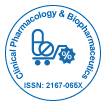Advancement in Thalassemia Treatment: A View from Gene Therapy
Received: 25-Jan-2018 / Accepted Date: 02-Feb-2018 / Published Date: 05-Feb-2018 DOI: 10.4172/2167-065X.1000e131
Editorial
Thalassemia is a group of genetic disorders resulting in the synthesis of little or no α-chains or β-globin chains which leads to haemoglobin deficiency and blood-related complications. The clinical signs may range from early thrombotic events to numerous complications such as pulmonary hypertension, infections, endocrine dysfunction and sometimes leg ulcers [1]. The clinical signs displayed are based on the degree of alpha to non-alpha globin chain imbalance, genetic and environmental factors. Regular blood transfusion is required for betathalassemia major patients to survive [2]. This can cause iron overload which might lead to severe problems like liver diseases, splenomegaly, transfusion-related acute lung injury, and coagulation abnormalities, red cell all and delayed haemolysis, iron overload, Immune System Effects [3]. Even with blood transfusion, only 50-65% of patients live beyond the age of 35 years in high-income countries as per existing literature [4-6].
Among beta-thalassemia patients, only a few have an option of curative treatment of allogeneic transplantation of hematopoietic stem and progenitor cells [7,8]. Gene therapy in focusing autogenic hematopoietic stem cell transplantation, which is currently on Phase-3 clinical trial would answer many unsolved questions and particularly the permanent cure to the thalassemia patients in coming years.
One of the important obstacles for successful transplantation is the limited number of HLA-matched related donors within families. As per the reports suggested, nearly 60% of thalassemics patients lack a suitable donor. Transplant-related mortality ranges nearly 20% among thalassemia patients who receive stem cell transplantation from matched unrelated donors [9,10]. Hence the complication increases further in the cure of thalassemia disease.
Furthermore, the choice of future research on gene-therapy studies has been on human erythropoietin stem cells from beta-thalassemia patients, which progressively lure scientists to work on induced pluripotent cells [11]. Globally widespread single-gene disorder Thalassemia and sickle cell disease can only be cured by allogeneic hematopoietic stem cell transplantation but very few studies are in the process of these topics, especially in autogenic hematopoietic stem cell transplantation on thalassemia cases.
There were many limitations for using genetic materials as therapeutic agents which includes poor bioavailability, formulation, and delivery to the site of action, delayed recanalization compared to conventional medicines [12]. Understanding the in vivo disposition of DNA, and how this disposition may be modulated in accordance with conventional medicines would be necessary for developing practical and clinically useful gene therapies for thalassemia treatment [13].
The genetic technology to treat human disease has led to lead to various thoughts for numerous researchers from the diverse range of disciplines. Gene therapy has been an inexhaustible area of research, particularly when it comes to thalassemia as there is very limited therapeutics as such in the complete cure of the disease and therefore it continues to gain substantial attention. However, the use of genetic material as therapeutic agents has produced many novels and challenging obstacles that remain to be overcome. In Summary, allogeneic transplantation remaining a viable treatment option for thalassemia patients is not sufficient, as even in that 30% of transplantrelated mortality occurs [14]. It is essential that new and novel approaches such as Autogenic transplantation through gene therapy should be brought into light for future potential topics for research.
References
- Hongeng S (2006) Outcomes of transplantation with related- and unrelated-donor stem cells in children with severe thalassemia. J Am Soc Blood Marrow Transplant 12: 683-687.
- Minchin RF, Orr RJ, Cronin AS, Puls RL (1999) The pharmacology of gene therapy. Croat Med J 40: 381-391.
- Lucarelli G, Isgrò A, Sodani P, Gaziev J (2012) Hematopoietic Stem Cell Transplantation in Thalassemia and Sickle Cell Anemia. Cold Spring Harb Perspect Med 2: 5.
Citation: Thiyagarajan A (2018) Advancement in Thalassemia Treatment: A View from Gene Therapy. Clin Pharmacol Biopharm 7: e131. DOI:
Copyright: ©2018 Thiyagarajan A. This is an open-access article distributed under the terms of the Creative Commons Attribution License, which permits unrestricted use, distribution, and reproduction in any medium, provided the original author and source are credited.
Share This Article
Recommended Journals
51ºÚÁϳԹÏÍø Journals
Article Tools
Article Usage
- Total views: 5445
- [From(publication date): 0-2018 - May 02, 2025]
- Breakdown by view type
- HTML page views: 4547
- PDF downloads: 898
